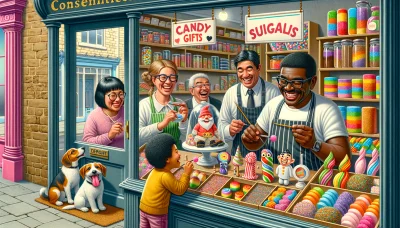Celiac-Safe Gluten-Free Confections Quiz
Test Your Knowledge
Question of
Understanding Celiac Disease and Gluten Sensitivity
What is Celiac Disease?
Imagine a world where the mere presence of a minuscule protein could cause your body to turn against itself. This is the reality for those of us with celiac disease, an autoimmune condition triggered by gluten, found in wheat, barley, and rye. When gluten enters our system, it's like an unwelcome guest that causes chaos in the serene home of our small intestine. The immune system mounts an attack, but unfortunately, it's our own tissues that bear the brunt of this battle.
It's not just about avoiding bread and pasta; gluten lurks in many places you wouldn't expect. Eating out becomes a game of culinary detective work, ensuring that every morsel is safe to savor. And trust me, when you find a place that understands and caters to your needs with delicious celiac-safe gluten-free confections, it feels like you've struck gold.
Symptoms of Celiac Disease
With celiac disease, the body sends out distress signals in various forms. For some, it's digestive upheavalcramping, bloating, and a dance with diarrhea or constipation. For others, it's fatigue that clings like a heavy coat or iron-deficiency anemia that leaves you pale and panting after a flight of stairs. And let's not forget the less talked about symptoms: the brain fog that makes your thoughts feel like they're wading through molasses or the sudden unexplained mood swings.
There are those who wear their symptoms on their skin with dermatitis herpetiformisitchy blisters that beg to be scratched. And then there are silent celiacs who walk among us symptom-free until theyre blindsided by a diagnosis after complications arise. Our experiences may differ, but we share a common need for strict adherence to a gluten-free lifestyle.
Diagnosis and Treatment
The path to diagnosis often feels like wandering through a maze blindfolded. Blood tests can indicate the presence of specific antibodies signaling celiac disease, but it's the endoscopy that reveals the true extent of the damagethe flattened villi crying out for respite from gluten's onslaught.
The only current treatment? A lifelong commitment to a strict gluten-free diet. No cheats days. No "just-a-little-bit-won't-hurt." Its about relearning how to eat and finding joy in flavors beyond wheat. It's empowering to take control of your health one meal at a timeeven if initially it feels like you're giving up so much.
Long-Term Health Implications
- Osteoporosis: Weakened bones silently losing their strength as malabsorption hinders calcium intake.
- Lymphoma: A whisper of fear at every check-up, knowing we have an increased risk for certain cancers.
- Infertility: Dreams of family possibly clouded by unseen hurdles.
- Neurological Disorders: Nervous systems under siege as gluten can affect more than just our guts.
Gluten Sensitivity vs. Celiac Disease
Defining Gluten Sensitivity
Non-celiac gluten sensitivity is like celiac diseases shadowit mimics many symptoms without the autoimmune component or intestinal damage. Its elusive and often misunderstood; even within the medical community debates ensue about its very existence.
But for those who experience its effectsa bite of bread leading to bloating or pasta precipitating headachesits all too real. The solution seems simple: eliminate gluten and feel better. Yet, theres no definitive test for sensitivity as there is for celiac disease, leaving many in limbo between relief and uncertainty.
How It Differs From Celiac Disease
While both conditions demand a breakup with gluten, celiac disease involves an immune system betrayala case of mistaken identity where one's own tissues are collateral damage in the war against gluten proteins.
In contrast, non-celiac gluten sensitivity doesnt scar ones villi nor raise antibodies ready for battle; instead, it presents a puzzle where pieces seem to fit yet create an incomplete picture. Despite these differences, both journeys converge on a path free from wheats winding ways.
Managing Symptoms
Living with either condition requires vigilancea constant awareness of what we consume and how our bodies might react. Dining becomes strategic; recipes adapt; kitchens transform into safe havens from cross-contamination.
Whether navigating celiac disease or non-celiac gluten sensitivity, each meal is an opportunity for wellness or discomfortthe choice lies within our grasp if we listen intently to our bodys whispers and sometimes roars.
The Importance of Gluten-Free Diets
Health Benefits for Celiacs
Embracing a gluten-free diet isnt merely about avoidanceits about discovery. For those with celiac disease, it means reclaiming health one crumb at a time. Energy levels rise like dough free from the heaviness of gluten; bellies soften without wheats wrath inciting inflammation within.
Vital nutrients finally find their way into once-hostile territorythe small intestineand begin healing years of unintended self-harm caused by unknowingly ingesting enemy proteins disguised in comforting carbs.
Risks of Gluten Contamination
The perils of cross-contamination are reallike invisible landmines on our plates waiting to trigger an autoimmune response. A shared toaster becomes a battleground; even condiments can harbor traces left behind by knives contaminated with crumbs.
We learn to ask questions until were blue in the faceto ensure kitchen staff understand just how serious gluten-free must be taken when preparing our food.
Whole Foods vs Processed Gluten-Free Products
Navigating grocery store aisles becomes an exercise in label scrutinyseeking out those precious words certified gluten-free while sidestepping processed foods masquerading as healthy simply because they lack gluten.
Yet amidst these challenges lie victorieseach safe meal reinforcing our resilience and each delectable bite reminding us that flavor need not be sacrificed at the altar of dietary restrictions.
Essential Ingredients for Gluten-Free Confections
Gluten-Free Flour Alternatives
Embarking on the quest to create delectable gluten-free treats can be as thrilling as it is challenging. As someone who has walked this path, I've found that the key lies in the heart of every confectionthe flour. Traditional wheat flour is off-limits, but thankfully, there's a treasure trove of gluten-free flours ready to take its place, each with its own character and charm.
Rice Flour and Its Uses : Imagine the subtle sweetness and lightness that rice flour brings to your baked goodsit's like a soft whisper of flavor that complements rather than overwhelms. It's my go-to for creating airy textures in cakes and a crispness in cookies that just begs for another bite.
Almond Flour and Nutritional Benefits : Then there's almond flour, with its rich, nutty essence that seems to dance on your palate. Not only does it infuse your creations with a depth of flavor, but it also sneaks in protein and fiber, making indulgence feel a tad more virtuous.
Coconut Flour for Dietary Variety : And let's not forget coconut floura tropical twist that's both absorbent and filling. It demands a bit of finesse to balance the moisture in recipes, but when done right, it adds an exotic flair that transports you straight to paradise with every mouthful.
Natural Sweeteners in Gluten-Free Baking
The melody of sweetness in gluten-free baking doesn't have to come from white sugar alone. There's a symphony of natural sweeteners out there, each bringing their unique notes to the table without missing a beat on flavor or texture.
Honey and Maple Syrup : Drizzling honey or maple syrup into your batter is like weaving liquid gold through your dessertseach one carries a distinct aroma that can make a simple recipe feel like an opulent treat. Plus, they add moisture which can be particularly beneficial in gluten-free baking where dryness sometimes lurks around the corner.
Stevia and Sugar Alcohols : For those watching their sugar intake, alternatives like stevia or sugar alcohols become the secret agents of sweetness. They work undercover to provide the sugary taste without spiking glucose levelstruly a covert operation for healthier confections.
Fruit Purees as Sweeteners : Lastly, fruit purees are my personal favorite understudies for sugar. Applesauce or mashed bananas not only sweeten naturally but also bring an added layer of moistness and flavor complexity that makes each bite a delightful surprise.
Binders and Leavening Agents
In the realm of gluten-free baking, binders and leavening agents are the magicians behind the scenes, ensuring everything sticks together and rises to the occasionquite literally!
Xanthan Gum and Guar Gum : Xanthan gum is like the spell caster that conjures up elasticity within doughs and batters, mimicking glutens binding properties. A sprinkle of guar gum can also work wonders by keeping ingredients united in harmonious texture without compromising taste.
- Baking Soda and Baking Powder: These are the trusty sidekicks that breathe life into flat landscapes of doughwatching them work is like witnessing tiny bubbles of air lift spirits (and cakes!) up towards lofty heights.
- Eggs: The classic bindereggsare natures glue in culinary arts. They hold pieces together with grace while contributing richness to every creation.
- Flaxseed: For those seeking plant-based alternatives, flaxseed acts as an earthy binder that doubles as a source of omega-3 fatty acidsits health and heartiness all rolled into one.
No matter which ingredient you choose from this list, remember that each has its own personality that will shine through in your creations. Embrace them with open arms (and ovens!), experiment joyfully, and watch as your celiac-safe gluten-free confections become not just food but an expression of creativity and love.
Crafting Delicious Gluten-Free Recipes
Embarking on the journey to create gluten-free recipes that tantalize the taste buds without compromising on flavor is a delightful challenge that I have come to love. It's like painting on a fresh canvas, exploring a variety of flavors and textures that cater to those of us with celiac disease or gluten sensitivity. The aroma of freshly baked gluten-free treats wafting through the kitchen is an invitation to indulge in the art of culinary creation, where every ingredient is chosen with care and every recipe is a testament to the joy of inclusive baking.
When I first ventured into the world of gluten-free baking, I was met with a mix of trepidation and excitement. Would these creations live up to their glutenous counterparts? The answer, I found, was a resounding yes. With alternative flours like almond, coconut, and rice flour at my disposal, each recipe became an adventure. The process of trial and error led me to discover not just substitutes but entirely new realms of flavor and texture. It's empowering to realize that living gluten-free doesn't mean saying goodbye to indulgenceit means redefining it.
And so, with each sift and stir, I've learned that gluten-free confections are not just about avoiding glutenthey're about celebrating diversity in baking. They're about creating moments of happiness for those who have often felt left out of the simple joy of enjoying a pastry or a slice of cake. These recipes are my love letters to all who crave that bite of sweetness without worrya reminder that deliciousness knows no bounds.
Breakfast Treats to Start Your Day
Mornings hold a special kind of magicthe soft glow of sunrise, the quiet before the day unfoldsand what better way to greet the day than with mouthwatering gluten-free breakfast treats? I remember the first time I perfected my fluffy pancake recipe; it felt like triumph. Drenched in maple syrup with a pat of butter melting on top, these pancakes were indistinguishable from their wheat-based relatives. Each bite was a celebration, an affirmation that yes, this is what mornings should taste like.
The scent of cinnamon-spiced muffins and fruit-laden breakfast bars cooling on the counter can lift even the sleepiest spirits. There's something inherently comforting about unwrapping a tender muffin or breaking off a piece of chewy granola barlike opening a small gift as you sip your morning coffee or tea. These are moments worth savoring, small acts of self-care wrapped in parchment paper.
And let's not forget about granola and oatmeal variationscrunchy clusters and creamy oats that invite customization with every spoonful. Whether studded with nuts and seeds or adorned with fresh berries, these wholesome options don't just nourish the body; they feed the soul with their simple goodness.
- Gluten-Free Pancakes and Waffles: Light and airy delights that promise a joyous beginning to any day.
- Muffins and Breakfast Bars: Portable pleasures brimming with fruits, nuts, or chocolate chips for those on-the-go mornings.
- Granola and Oatmeal Variations: A versatile canvas for your favorite toppingsperfect for customizing your dawn-time indulgence.
Decadent Desserts and Pastries
The world of desserts is where gluten-free baking truly shinesa realm where creativity knows no bounds. Cakes rise majestically in their pans while cupcakes sit like jewels waiting to be frosted with swirls of buttercream. Each one is an opportunity to prove that living gluten-free can be synonymous with opulent flavors and textures that melt in your mouth.
Cookies have always been my go-to comfort foodthere's something undeniably nostalgic about biting into a chewy chocolate chip cookie or savoring the rich fudginess of a brownie. But recreating these classics without gluten presented an exciting challenge: How do you maintain that beloved chewiness or crackly top? Through experimentation with blends of flours and gums, I unlocked secrets that would satisfy even the most discerning cookie aficionado.
Pies and tarts possess an elegance that captivates me every timethe way the filling nestles into the crumbly crust speaks volumes about love baked into every slice. Crafting gluten-free crusts has been both an art form and act of devotion; ensuring they hold together yet crumble just right requires patience but yields immense satisfaction when done well.
Savory Snacks and Appetizers
The allure of savory snacks often lies in their simplicitya crunchy breadstick here, a flavorful cracker thereeach serving as tiny morsels packed with taste. As someone who cherishes these bites alongside evening drinks or as prelude to dinner parties, finding ways to make them without gluten has been nothing short of rewarding.
The beauty in quiches and savory tarts lies within their versatility; they're canvases for whatever vegetables or cheeses you have on hand, encased in flaky crusts that hint at mastery in the kitchen. Discovering how different flours affect texture has been akin to uncovering hidden treasuresa little more millet flour for crispness here, some tapioca starch for lightness thereand suddenly you have appetizers worthy of any gathering.
Dips and spreads invite convivialitythey're shared dishes meant for laughter-filled rooms where crackers dip into creamy hummus or smoky baba ghanoush. Crafting these accompaniments without gluten doesn't diminish their ability to bring people together; if anything, it enhances it by ensuring everyone can partake in their deliciousness without hesitation.
Navigating Gluten-Free Labeling and Certification
Embarking on the journey of a gluten-free lifestyle, especially for those with celiac disease, is like learning a new language. The aisles of grocery stores transform into a maze where every turn requires vigilance and every choice demands scrutiny. It's not just about avoiding wheat, barley, and rye; it's about understanding that gluten can be a clandestine stowaway in countless products.
As I first took steps into this new world, I remember the overwhelming sensation as I stood in front of shelves lined with products brandishing different labels. "Gluten-free," "No Gluten," "Free of Gluten" - these phrases became both my guides and my puzzles. There was an art to interpreting the hieroglyphs that are food labels, an art I was determined to master for the sake of my health and palate.
Understanding Food Labels and Ingredients Lists
I can still recall the first time I held a seemingly innocent product in my hands, its ingredients list reading like a foreign script. Maltodextrin, dextrin, modified food starch - were these safe? With each shopping trip, I became more fluent in identifying hidden sources of gluten, recognizing that these cryptic terms could indeed contain the very protein I was trying to avoid.
Deciphering food label terminology became my weekly crossword puzzle. "Wheat-free" did not always mean safe for celiacs; it was a tricky distinction to make. Allergen statements, often found in bold or italics at the end of ingredient lists, became my saving grace. They served as the cliff notes version of whether or not I could indulge in that chocolate chip cookie or slice of cheesecake.
The Significance of Gluten-Free Certification
The day I discovered products with gluten-free certification marks felt like stumbling upon treasure. These marks were more than just stamps; they symbolized safety and trust. Certification meant that an independent organization had vetted the product rigorously against strict standards for gluten content.
Certifying organizations such as the Gluten Intolerance Group (GIG) and Celiac Support Association (CSA) became familiar friends. Their seals were a beacon of hope on packaging, assuring me that what lay within was free from cross-contamination and met stringent gluten-free standards.
- What Does Certification Mean? : It signifies that a product has passed rigorous testing to ensure it meets specific criteria for being free from gluten.
- Organizations That Offer Certification : These include GIG's Gluten-Free Certification Organization (GFCO), CSA's Recognition Seal Program, among others.
- How Certification Ensures Safety : Certified products undergo periodic testing and facility inspections to maintain their status, providing peace of mind for consumers with celiac disease or gluten sensitivity.
Tips for Shopping Gluten-Free Products
The wisdom gained from years of navigating gluten-free living has become one of my most cherished tools. When shopping for gluten-free products, it's crucial to have a mental list of trusted brands whose commitment to celiac-safe confections is unwavering. Yet even with familiar brands, I've learned never to grow complacent always read labels quickly but thoroughly to catch any changes that may have occurred since your last purchase.
Finding specialty items used to be akin to a scavenger hunt without clues. Now with increased awareness and demand for gluten-free options, many grocery stores have dedicated sections making it easier than ever before. But when in doubt, local health food stores and online specialty shops are treasure troves waiting to be explored offering everything from artisan breads to gourmet pastries that cater specifically to our needs.
The Art of Gluten-Free Baking Techniques
Embarking on a gluten-free baking journey is like opening the doors to a whimsical kitchen where each ingredient holds its own secret superpower. When you first step in, the absence of gluten might seem like a daunting challenge, sending your culinary compass spinning. But fear not! With some patience and playful experimentation, you'll soon find that mastering gluten-free doughs and batters is an adventure that tickles not just the taste buds but also the soul.
For those who live with celiac disease or gluten sensitivity, the quest for celiac-safe gluten-free confections is more than just a casual dalliance with alternative floursit's a necessity. Yet, this pursuit can morph into a passionate craft, where every successful loaf or pastry feels like a personal triumph. It's about transforming what could be seen as a restriction into an exploration of flavors and textures that are bound to surprise and delight.
Mastering Gluten-Free Doughs and Batters
Mixing and Handling Techniques
Doughs and batters without gluten don't behave quite like their wheat-based counterparts. They often require a gentle touch and an understanding that they will be more delicate. The proteins in wheat flour that create gluten give elasticity to dough, so when you're working without it, expect mixtures that are stickier and less forgiving. But here's where the magic happens: blends of rice flour, tapioca starch, and xanthan gum can conjure up textures that dance close to the original tune. The key is to mix until just combinedoverworking is the nemesis of lightness in gluten-free baked goods.
There's a certain zen in smoothing out gluten-free cookie dough with your hands or folding air into cake batter with a spatula; it's almost meditative. And when you get it rightoh! The first bite is like catching a glimpse of sunrise after a long night: pure, warm satisfaction.
Adjustments for Altitude and Humidity
The alchemy of baking at high altitudes can turn even seasoned bakers' confidence into pudding. Throw in the curveball of no gluten, and you've got yourself quite the puzzle. Higher elevations call for increased moisturean extra dollop of apple sauce or a splash more almond milk might do the trickand perhaps a smidge less leavening agent to prevent your creations from rising too quickly and then collapsing.
Humidity laughs in the face of precision; it will toy with your ingredients like a cat with yarn. In damp climates, your flour may need to be reduced ever so slightly to combat stickiness. And dry environments? They beg for more moisture to keep those crumbs from turning into desert sand. It's all about balancelike walking a tightrope while juggling eggs and sugar.
Achieving the Right Texture
The siren song of perfect texture can lead many astray on their gluten-free voyage. The goal? A crumb that holds together without being dense, one that whispers "tender" rather than shouting "tough." This is where substitutes such as almond flour can be heroes, lending their fatty softness to your baked symphony. Eggs are allies toowhisked whites add lift while yolks bring richness.
Bite into a slice of bread that has nailed this elusive balance, and it's almost spirituala symphony of airy pores encased in a crust that crackles just so under pressure from eager fingers. You close your eyes as you chew; each morsel reaffirms your belief in what's possiblewith or without gluten.
Creative Decorating Without Gluten
Icing, Glazes, and Toppings
Now let's talk about adornmentthe crowning jewels atop our gluten-free treasures. Icings made from powdered sugar replacements glisten atop cupcakes like frost on winter mornings; glazes laced with lemon zest drizzle down cake sides in rivulets of tangy sweetness; toppings sprinkle across surfaces like confetti at life's celebration paradeall without so much as whispering "gluten."
A swirl here, a dollop thereeach motion is an expression of joy, an artistic flourish on top of something already beautiful in its simplicity. It's not just about making it look pretty (though who doesn't love some eye candy?), but also about adding layers of flavor that complement the base without overwhelming it.
Edible Flowers and Natural Colorants
- Edible Flowers: Imagine biting into soft lavender-hued frosting topped with delicate violet petalsits as if you're tasting spring itself.
- Natural Colorants: Spirulina paints pastries in mystical blues while beet juice infuses them with rosy hues; these natural wonders allow us to paint our confections with the colors of nature while keeping them gloriously gluten-free.
- Presentation Ideas: A final sprinkle of edible gold dust transforms an ordinary chocolate truffle into an orb fit for royaltyor at least makes it feel that way as it melts sumptuously on your tongue.
The use of edible flowers isn't simply aestheticit tells stories on our plates; marigold whispers tales of golden summer afternoons while rose speaks softly of loves sweet fragrance. And when we choose natural colorants over artificial ones, we're not only honoring our bodies but also Mother Earth herselfwhat could be more empowering?
Storage Tips for Freshness and Safety
Best Practices for Counter Storage
The counter is where freshly baked goods strut their stuffbut only for so long before staleness creeps in like an uninvited guest at the party. To keep cookies crisp and muffins moist, they must be swaddled carefully in their parchment paper blankets or nestled snugly within air-tight containersits akin to tucking them into bed after their grand debut.
You learn quickly which confections are divas demanding center stage on your kitchen island and which prefer the cool solitude behind cupboard doorsa dance between visibility and preservation where intuition becomes your choreographer.
Refrigeration and Freezing Techniques
Fridges are sanctuaries for pies yearning for longevity; freezers are time capsules for bread dreaming of future feasts. Refrigeration slows down spoilages relentless marcha shield against molds encroaching sporeswhile freezing suspends it entirelya pause button on lifes relentless playback.
To freeze or not to freeze? That question hovers over every leftover slice like Shakespearean dramawith apologies to Hamletwherein lies the rub: frostbite can turn tender cake into something reminiscent of cardboard if wrapped carelessly. But swaddle them rightin layers upon layersand what emerges upon thawing is as close to fresh-baked nirvana as one can hope for sans oven warmth.
Reviving Stale Gluten-Free Baked Goods
Sometimes despite our best efforts, yesterdays bread goes roguehardened edges defying butter knives attempts at penetrationbut all is not lost! There exist tricks learned from grandmothers kitchens where nothing was ever wasted: Stale slices resurrected by brief stints in ovens or transformed through sorcery (also known as French toast).
Ancient grains become modern marvels when given second chances; they remind us that even within constraintsbe they dietary or otherwisethere exists room for creativity, redemptionfor life itself to unfurl anew amidst aromas wafting from warming racks filled with second-day confections finding their second wind.
Health Benefits of Indulging in Gluten-Free Confections
Nutritional Advantages of Alternative Ingredients
You know that moment when you bite into a lusciously moist slice of gluten-free cake, and the world just fades away? It's not just about dodging the gluten bullet; it's a symphony of flavors, textures, and yes, nutritional perks! Let's talk about those high-protein flour substitutes. Almond flour isn't just for making your kitchen smell like a nutty paradise; it packs a protein punch that keeps you feeling fuller longer. And have you tried chickpea flour? It's like the Clark Kent of the baking worldunassuming until it reveals its superpowers: protein and fiber wrapped in one.
Speaking of fiber, let's not skim on those fiber-rich additions to your diet. When I first switched to gluten-free living, I thought I'd waved goodbye to my beloved bread with all its hearty goodness. But then I discovered the wonders of flaxseed meal and chia seedstiny but mighty heroes that transform your treats into fiber feasts. These little guys are like the best friends who always have your back, keeping everything moving smoothly if you catch my drift.
And let's sweet talk for a second about those natural sweeteners brimming with vitamins and minerals. Pure maple syrup and honey aren't just for drizzling over pancakes; they're nature's way of saying, "Here, have some antioxidants with your sweetness." It's like getting a hug from Mother Nature herself every time you indulge.
Impact on Digestive Health
Did you ever think that treating yourself could actually ease digestive discomfort? Imagine savoring a slice of gluten-free sourdough bread that not only dances on your taste buds but also brings probiotics to the party in your gut. It's like each bite is saying, "Let's make peace with your belly." The role of a balanced diet can't be overstated when it comes to digestive health. A little indulgence balanced with nutrient-rich foods makes for happy insides.
Oh, and let me tell you about probiotics in gluten-free sourdough! This is no ordinary bread; its practically a wellness retreat for your gut flora. Fermented with love (and beneficial bacteria), this tangy treasure helps maintain a flourishing microbiome. Its like each slice is an invitation to a spa day for your digestive system.
The balance in what we eat is keya harmonious blend of taste and health. Gluten-free confections can be part of this equilibrium, surprising our palates while keeping our insides running like a well-oiled machine. Think diverse meals with vibrant veggies, lean proteins, and the occasional sweet treat as the cherry on top!
Weight Management and Energy Levels
We all know that feeling when we're trying to watch our weight but can't stop dreaming about dessert. Here's some sweet news: calorie control in gluten-free treats is totally doable! With alternatives like coconut sugar and agave nectar, you can still enjoy that cookie without tipping the scales. It's all about savoring without overindulginglike having just enough room for dessert without needing to loosen your belt.
And when it comes to sustained energy from complex carbs, gluten-free doesn't mean fun-free. Brown rice flour and quinoa are not just for health buffsthey're energy-boosting powerhouses that keep you going without the crash. Imagine biting into a chewy cookie that fuels your fire instead of leaving you slumped over your desk at 3 p.m.
- Banana Oatmeal Muffins: A match made in heaven between ripe bananas and whole grain oats.
- Nut Butter Energy Balls: Little orbs of joy packed with seeds and nut butter for lasting energy.
- Fruit-and-Nut Bars: Chewy bars loaded with dried fruits and nutsa portable pantry staple for those on-the-go days.
Last but not least, finding snack ideas for weight maintenance can be as delightful as experimenting in a candy labminus the guilt! Ever tried homemade fruit-and-nut bars or banana oatmeal muffins? They're like little bundles of joy that keep both your waistline and taste buds delighted. So go ahead, whip up some nut butter energy balls or bake those heart-healthy muffins; managing weight has never tasted so good!
Building a Gluten-Free Kitchen and Lifestyle
Embarking on a gluten-free journey can be as daunting as it is necessary, especially when you're doing it for health reasons, like managing celiac disease. It's not just about avoiding wheat, barley, and rye; it's about creating a sanctuary where your senses can revel in the aromas and textures of celiac-safe confections without the shadow of gluten lurking in the background.
The transformation begins with your kitchen that sacred space where culinary magic unfurls. It's more than a place; it's an extension of yourself, a reflection of your commitment to a lifestyle that embraces both necessity and joy. So let me take you through the alluring dance of setting up a gluten-free kitchen that is safe, efficient, and utterly delightful.
Setting Up Your Gluten-Free Pantry
Imagine opening your pantry doors to shelves lined with jars filled with promise each ingredient a building block for a masterpiece. A gluten-free pantry is a treasure trove of flavors waiting to be discovered and savored.
Must-Have Staples for Everyday Cooking
A whisper of rice flour here, a scoop of almond meal there these are the notes that compose the symphony in a gluten-free kitchen. Stocking up on gluten-free flours like sorghum or teff flour can transform your baking from ordinary to extraordinary. Don't forget starches such as arrowroot or potato starch; they're like the silent heroes that give your creations structure and form. And for that touch of sweetness? Ah, coconut sugar and pure maple syrup sing their sweet melodies without missing a beat.
But it's not just about the sweets. Quinoa, certified gluten-free oats, and an array of lentils lend their hearty textures to your culinary compositions. The rhythm of these essentials creates harmony in dishes from breakfast porridge to evening stews.
Organizing for Cross-Contamination Prevention
The specter of cross-contamination can loom large in our kitchens, but with clever organizing and vigilant practices, we can keep our food safe and our minds at ease. Dedicate specific areas for your gluten-free items high shelves where wheat cannot trespass or separate cupboards that house only gluten-free fare.
Consider color-coding your utensils or using clear storage containers with bold labels make it so that anyone stepping into your kitchen would know, without doubt, which tools are dedicated to your gluten-free artistry. And always have separate toasters and cutting boards; they are notorious hideaways for gluten crumbs.
Labeling Strategies for Safe Storage
A label is not just a label; it's peace of mind. It whispers assurances that what you're about to consume is safe in its simplicity. Invest in waterproof labels or chalkboard tags something durable yet charming and mark each container with love and precision.
- Date Labels: Keep track of freshness by marking purchase or opened dates.
- Allergen Alerts: Boldly state if contents contain allergens for those shared household moments.
- Dish Inspirations: Sometimes jot down what dish this ingredient stars in - let it inspire you!
Tools and Equipment Essentials
The clink of measuring spoons, the whirr of mixers these are the sounds that accompany the ballet of baking. But when you're waltzing through recipes with celiac-safe ingredients, having the right tools isn't just convenient; it's crucial.
Non-Stick Bakeware for Perfect Results
Gone are the days when being gluten-free meant bidding adieu to golden crusts and springy sponges. With non-stick bakeware at hand, every muffin pops out ready to embrace its frosting crown without leaving half its soul clinging to the pan.
Cakes slide out effortlessly onto cooling racks, waiting patiently as you whip up frostings from dairy-free butter substitutes spiked with vanilla bean paste an alchemy only possible with bakeware that understands your needs.
Silicone Mats and Parchment Paper Uses
Unfurling rolls of parchment paper or laying down silicone mats is akin to rolling out the red carpet for your baked goods; they ensure nothing sticks out of turn or burns at the edges. They're reusable guardians that protect not just your treats but also your pans from wear and tear.
Baking becomes less about scraping disasters off trays and more about marveling at how effortlessly cookies slide off surfaces as if they too understand their role in this dance of delicacy.
Mixers and Food Processors for Efficiency
A robust mixer stands on the counter like an old friend ready to lend an arm when yours grow weary from beating batters into submission. Whether it's folding air into angel cakes or kneading dough until it's smooth as silk mixers become extensions of our hands.
The food processor is no less essential; chopping nuts finely enough so they meld into doughs without protest or blitzing dates into paste for natural sweetening. These machines shorten our labors so we can spend more time savoring our creations instead of slaving over them.
Embracing a Gluten-Free Social Life
A life free from gluten doesn't mean isolation from social whimsy; rather, it offers an opportunity to craft gatherings around inclusivity and awarenessa chance to show how delightful celiac-friendly fare can be.
Hosting Inclusive Dinner Parties
I've learned through laughter-filled evenings that hosting dinner parties needn't be fraught with anxiety over dietary restrictions. Crafting menus where every dish is naturally gluten-free means everyone dines without fearpolenta rounds topped with ratatouille or roasted chicken rubbed with herbes de Provence accompanied by wild rice pilaf.
Desserts? They become adventures in texturemeringue nests cradling lemon curd or chocolate-dipped macaroons leaving trails of happiness on taste buds. And oh! The conversations sparked by shared discoveries!
Eating Out Safely at Restaurants
Dining out while maintaining a strict gluten-free diet used to feel like navigating a minefield blindfoldedbut no longer! I've learned to wield my questions like graceful swords: "Do you have a dedicated gluten-free menu?" "Can you ensure my meal is prepared away from any cross-contamination?" Armed with knowledge and kindness (and sometimes calling ahead), I find chefs willing accomplices in my quest for safe indulgence.
Tips whispered between friends have led me down cobblestone paths to eateries where chefs understand celiac intricacieswhere every bite is infused with trust as much as flavor!
Travel Tips for Celiac-Friendly Journeys
Voyages need not be voids devoid of deliciousness! Packing snacks like mixed nuts dusted with sea salt or homemade granola bars gives one confidence during flights or road tripssafe harbors in unfamiliar ports.
I've tucked away memories like souvenirsof finding bakeries abroad whose entire ethos revolves around celiac-safe practices, where I've savored pastries beneath sun-dappled skies without fear shadowing my joy. And isn't joy what we seekthe simple pleasure found in bites free from harm? It's therein every crumb we dare enjoy safelyits there waiting within reach.












